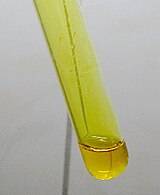
Back Chloordioksied AF ثنائي أكسيد الكلور Arabic دیاوکسید کولور AZB Хлорен диоксид Bulgarian Clorur de dioxigen Catalan Oxid chloričitý Czech Chlordioxid German Dióxido de cloro Spanish Kloordioksiid ET کلر دیاکسید FA
| |||

| |||
| Names | |||
|---|---|---|---|
| IUPAC name
Chlorine dioxide
| |||
Other names
| |||
| Identifiers | |||
3D model (JSmol)
|
|||
| ChEBI | |||
| ChemSpider | |||
| ECHA InfoCard | 100.030.135 | ||
| EC Number |
| ||
| 1265 | |||
| MeSH | Chlorine+dioxide | ||
PubChem CID
|
|||
| RTECS number |
| ||
| UNII | |||
| UN number | 9191 | ||
CompTox Dashboard (EPA)
|
|||
| |||
| |||
| Properties | |||
| ClO2 | |||
| Molar mass | 67.45 g·mol−1 | ||
| Appearance | Yellow to reddish gas | ||
| Odor | Acrid | ||
| Density | 2.757 g dm−3[1] | ||
| Melting point | −59 °C (−74 °F; 214 K) | ||
| Boiling point | 11 °C (52 °F; 284 K) | ||
| 8 g/L at 20 °C | |||
| Solubility | Soluble in alkaline solutions and sulfuric acid | ||
| Vapor pressure | >1 atm[2] | ||
Henry's law
constant (kH) |
4.01×10−2 atm m3 mol−1 | ||
| Acidity (pKa) | 3.0(5) | ||
| Thermochemistry | |||
Std molar
entropy (S⦵298) |
257.22 J K−1 mol−1 | ||
Std enthalpy of
formation (ΔfH⦵298) |
104.60 kJ/mol | ||
| Hazards | |||
| Occupational safety and health (OHS/OSH): | |||
Main hazards
|
Highly toxic, corrosive, unstable, powerful oxidizer | ||
| GHS labelling: | |||
  
| |||
| Danger | |||
| H271, H300+H310+H330, H314, H372 | |||
| P210, P220, P260, P264, P271, P280, P283, P284, P301+P310, P304+P340, P305+P351+P338, P306+P360, P371+P380+P375, P403+P233, P405, P501 | |||
| NFPA 704 (fire diamond) | |||
| Lethal dose or concentration (LD, LC): | |||
LD50 (median dose)
|
94 mg/kg (oral, rat)[3] | ||
LCLo (lowest published)
|
260 ppm (rat, 2 hr)[4] | ||
| NIOSH (US health exposure limits): | |||
PEL (Permissible)
|
TWA 0.1 ppm (0.3 mg/m3)[2] | ||
REL (Recommended)
|
TWA 0.1 ppm (0.3 mg/m3) ST 0.3 ppm (0.9 mg/m3)[2] | ||
IDLH (Immediate danger)
|
5 ppm[2] | ||
| Safety data sheet (SDS) | Safety Data Sheet Archive. | ||
Except where otherwise noted, data are given for materials in their standard state (at 25 °C [77 °F], 100 kPa).
| |||
Chlorine dioxide is a chemical compound with the formula ClO2 that exists as yellowish-green gas above 11 °C, a reddish-brown liquid between 11 °C and −59 °C, and as bright orange crystals below −59 °C. It is usually handled as an aqueous solution. It is commonly used as a bleach. More recent developments have extended its applications in food processing and as a disinfectant.
- ^ Haynes, William M. (2010). Handbook of Chemistry and Physics (91 ed.). Boca Raton, Florida, USA: CRC Press. p. 4–58. ISBN 978-1-43982077-3.
- ^ a b c d NIOSH Pocket Guide to Chemical Hazards. "#0116". National Institute for Occupational Safety and Health (NIOSH).
- ^ Dobson, Stuart; Cary, Richard; International Programme on Chemical Safety (2002). Chlorine dioxide (gas). World Health Organization. p. 4. hdl:10665/42421. ISBN 978-92-4-153037-8. Retrieved August 17, 2020.
- ^ "Chlorine dioxide". Immediately Dangerous to Life or Health Concentrations (IDLH). National Institute for Occupational Safety and Health (NIOSH).


